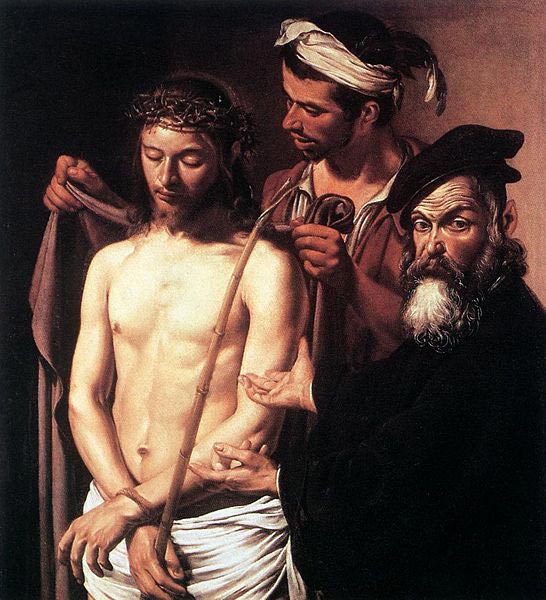| Ecce Homo | |
|---|---|
 |
|
| Artist | Caravaggio |
| Year | c. 1605 |
| Medium | Oil on canvas |
| Location | Palazzo Rosso, Genoa |
| Dimensions | 50 in × 41 in |
| 128 cm × 103 cm | |
| Famous Paintings by Caravaggio | |
| David with the Head of Goliath | |
| Medusa | |
| Bacchus | |
| Conversion of St. Paul | |
| Ecce Homo | |
| Narcissus | |
| Judith Beheading Holofernes | |
| Supper At Emmaus | |
| Sacrifice of Isaac | |
| Complete Works |
Caravaggio’s painting Ecce Homo depicts a scene taken from the New Testament. This painting combines the crowning of Christ’s head with thorns, and the mocking of Christ, with Pontius Pilate displaying Christ to the crowds, shouting Ecce Homo, or “behold the man.” The characters are painted in a mature and characteristic Roman period style. The forms are close-up, and he uses dramatic light to emphasize the Christ figure. There is a lack of depth and background, and the dark colors are evidence of the Baroque art movement of which Caravaggio was instrumental in developing.
There is signature psychological realism, characteristic of Caravaggio, in the torturer’s face, which seems to convey pity and sadism equally. Pilate is depicted as a rather stoic, or neutral character, looking away, and perhaps sympathetic. Some claim that Caravaggio used his own face as a model for Pilate. It is also thought that this painting was a companion work for other paintings of the Passion and life of Christ that Caravaggio had painted.
Inspiration for Ecce Homo
Cardinal Massimo Massimi asked for works, portraying the theme Ecce Homo, asking three different artists at the same time. The three artists were not informed that they were not the only artists who were commissioned by the Cardinal. They were each given the deadline of August, 1605. During the time between this signed commission, and the due date, Caravaggio was first, arrested for throwing rocks at a home, and assaulting a notary.
Because of these two unlawful offenses, Caravaggio traveled to Genoa. Cardinal Massimi chose painter Cigoli’s version of Ecce Homo, and it is undetermined whether it was preferred over Caravaggio’s, or whether Caravaggio did not complete his painting by the deadline, due to his previous troubles of the time.
Ecce Homo is an oil painting on canvas, in Baroque style, and religious theme, which was characteristic of the time period. It is 128 x 103 cm, and is displayed in an art gallery (Palazzo Rosso) in Genoa, Italy. There have been quite a few comparisons between Caravaggio’s and Cigoli’s versions of Ecce Homo, and they are very similar paintings, with Cigoli even using illumination on the figures with lighter colors of paint.